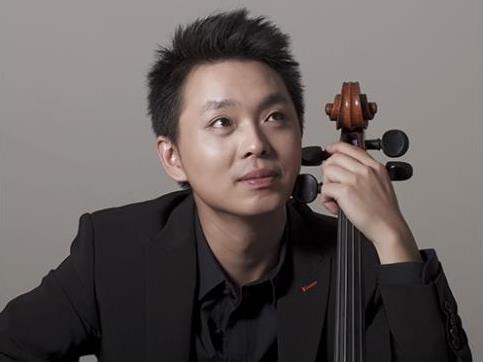Li-Wei Qin, photo by Dong Wang
The Melbourne Symphony Orchestra braved two epic Romantic canvases on Saturday night under the direction of German now Tasmanian conductor Johannes Fritzsch: Antonín Dvořák’s sole Cello Concerto in B minor, Op 104 B 191 (1894-95), with Li-Wei Qin as soloist and Robert Schumann’s third and final Symphony in E flat major, Op 97 Rhenish (1850).
Dvořák had difficulty starting his long-promised commission for cellist Hanuš Wihan owing to other commitments; but also because he admitted finding it difficult to write for solo cello with its ‘muddy’ lower and ‘nasal’ upper voice. The work was eventually written over four months in New York and is today one of the best-known cello concertos, though there are comparatively few in concert circulation. Although the composition was intended for Wihan, owing to scheduling problems it was first performed for the London Philharmonic Society in Queen’s Hall by Leo Stern with the composer conducting. Wihan performed the work only some years later in The Hague.
On Saturday, the opening Allegro took time to settle, given the soloist’s constant waxing and waning of tempo. The stern and emotional opening in B minor was beautifully contrasted by the heartfelt melody of the second subject in major first introduced splendidly by horn (guest principal, Valentin Eschmann) and then tenderly repeated by cello. The duetting clarinets with their lovely melodic lilt delighted in the central Adagio, ma non troppo. The movement’s core becomes an extensive dialogue between winds and soloists, especially the cadenza-like section with flutes that was seamlessly realised. The rondo Finale: Allegro moderato-Andante-Allegro vivo contains a melodic tribute to the composer’s ailing sister-in-law Josefina Kaunitzova. The soloist is then joined by solo violin (well played by Eoin Andersen) drawing the work to an exuberant close. Qin displayed an excellent technique throughout, with the opening movement’s infamous octave runs and double stops flawlessly executed. The enthusiastic response from the audience encouraged an unusual encore. The work by Sicilian composer Giovanni Sollima, Lamentatio (1998) is a fusion between East and West where the soloist accompanies himself with chant-like wordless singing.
The top-billed Schumann Symphony was preceded by a peculiar work by Manfred Trojahn, his Cinque Sogni per Eusebius (‘Five Dreams for Eusebius’), composed in 2010. The imaginary alter-ego characters of fiery and unrestrained Eusebius balanced by reticent and gentle Florestan populated Schumann’s early critical writings and piano cycles. This pensive, filmic mood setter, at once fragmented and edgy and then mellifluous and dreamy, moves through five short movements towards a faltering Mahlerian waltz that, after a tutti scream of stabbing mania, takes flight in a fright. Though it was well-performed, I found the work ineffectual on the whole, particularly over its wallowing and meandering central movements, and superfluous to the program.
Schumann suffered from mental instability for most of his short life. Following a particularly debilitating episode in 1844 when he was unable to compose, he and his wife Clara moved to Düsseldorf where in 1850 he began his last Symphony. His first two works in the genre had not been the success hoped for and it was wondered if his métier was more suited to smaller-scale forms. Schumann was urged to depict the majesty of the Rheinland in this work and the opening Lebhaft certainly meets this task with its strident opening theme in strings and brass over a large-scale, symphonic Sonata form. The Rhine had previously been an inspiration, particularly in his song Im Rhein, im heiligen Strome from Dichterliebe. There are sacred elements to this homage to the great river and significantly the Symphony is centred on the key of E flat major that Bach saw as representing the Holy Trinity and Wagner was to use twenty years later as the extended opening of his epic Das Rheingold.
Here was some of the best playing of this concert, where Fritzsch harnessed with confidence the grandeur of the composer’s vision. Originally called “Morning on the Rhine” the second movement Scherzo: Sehr mäßig was a well-judged slow Ländler, though it provided some difficulties for the horns. In November 1850, Clara and Robert visited Cologne by boat to attend the installation of the Archbishop of Cologne as cardinal. The fourth movement Feierlich is a powerfully evocative interpretation of the archbishop’s procession and accession to high office, superbly rendered by horns and trombones. Phrases seem to play over one another like an imagined great Bach Prelude and Fugue in a vast acoustic. The final Lebhaft returned from gothic grandeur to a more earthly ebullience in E flat major.
Here was a high-quality performance, though not the MSO at its best.
3 ½ stars out of 5
MSO Plays Schumann 3
Johannes Fritzsch, conductor
Li-Wei Qin, cello
Presented by Melbourne Symphony Orchestra
Hamer Hall, Arts Centre Melbourne
Saturday, 19 August, 2017
8pm





